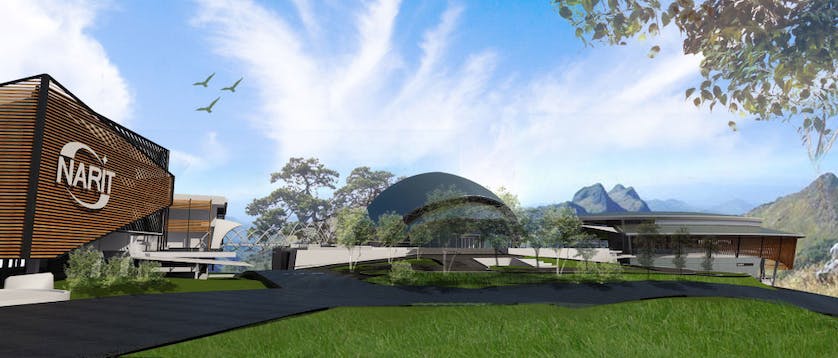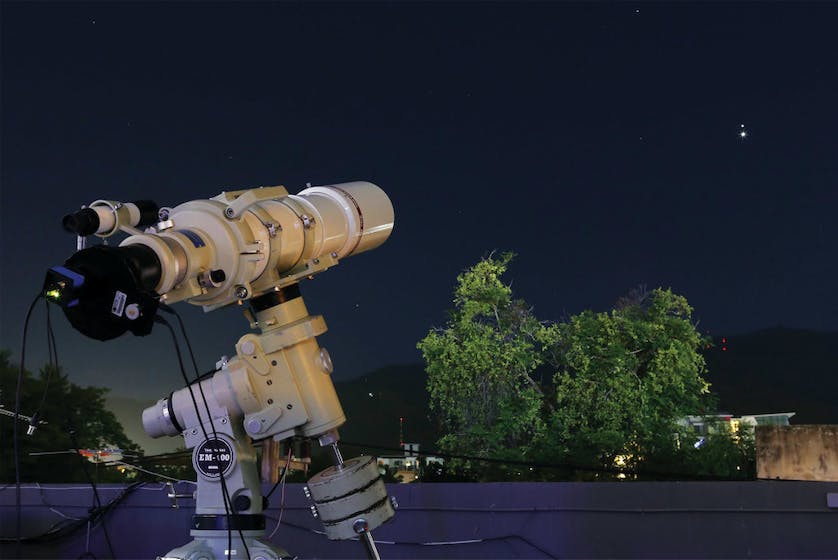Living in a relatively large city, with its lamp oil burning pretty much round the clock, Chiang Mai’s night sky is not commonly decorated with any expanse of celestial objects. Light and air pollution often bask the night in a peculiar orange glow, drowning out any cosmic light that those in rural areas can appreciate on a nightly basis. On the night of June 30th however, a certain cosmic duo performed a dance that took very little effort to observe even with the naked eye. That evening, I left my home with the intent of searching for a higher vantage point to observe the event. My plans for a night time stroll were cut short, however, as I simply walked out into the street and instantly spotted Venus and Jupiter, almost on top of one another, glowing vividly in the night sky just above Wat Phra That Doi Suthep.
Many others were watching the sky that night. Although the Venus and Jupiter conjunction is quite a frequent event, this year’s conjunction saw the planets come within two degrees of one another, some researchers claiming it the closest conjunction since the years 3 and 2 B.C., resembling what may have once been called The Star of Bethlehem. Additionally, because of Thailand’s position on the planet, the Venus Jupiter conjunction usually occurs during our morning or day, making it near impossible to see, while this event was timed perfectly for our viewing pleasure.

Among those watching the sky that night, but with a bit more sophistication and interest, was astronomer and researcher Korakamon Sriboonrueang of the National Astronomy Research Institute of Thailand (NARIT).
“We don’t learn anything new scientifically from observing the planetary alignment,” explained Korakamon to our small group of space enthusiasts from Citylife huddled around his laptop in the library of the NARIT headquarters in Chiang Mai. “But exciting events like this instils interest and fascination with space and astronomy. It encourages people to learn more about science, and we are always excited to share the wonders of the galaxy with people.”
Korakamon flipped through some beautiful photos of the planetary conjunction captured with NARIT’s massive telescope that rests on Doi Inthanon and explained that over the next couple of weeks Venus, Jupiter and the moon will provide us with several different arrangements as the moon revolves around the earth, and Venus and Jupiter continue on their long orbits around the sun. One of these arrangements results in what is commonly referred to as a “smiling moon,” where the two planets form what resembles two eyes, and a crescent moon serves as a smiling mouth.
While the planetary conjunction caused our gaze to turn skywards, NARIT is also at the crest of some amazing developments that are only adding to Chiang Mai’s capabilities and further solidifying the city as Southeast Asia’s main centre for astronomical research.
In February of this year, NARIT announced that it had been commissioned to construct a new 400 million baht Astro Park in Chiang Mai province. Construction of the park, set on around 50 rai of land in Mae Rim, is already underway, with the mechanical workshop and aluminium milling and coating buildings already complete.
“This park will serve as a training facility, an educational institution, and a hub for all Thai observatories around the country and internationally,” explained NARIT director Boonrucksar Soonthornthum “It will feature a four-story new headquarters for NARIT, which includes offices, laboratories and meeting rooms, and other facilities will include a new observatory, which will feature a 1.72 metre wide telescope and various smaller telescopes that can be used by the public. A planetarium with full dome projection will also be constructed that will be used for both indoor and outdoor presentations and will seat up to 200 people.”

The park has a prime location in Chiang Mai, director Boonrucksar explains, as it is in close proximity to the national observatory set on Doi Inthanon, featuring a 2.54 metre wide telescope set at 2,457 metres above sea level on Thailand’s tallest mountain, allowing researchers to observe the sky while already being above level two clouds. The park will also link together five regional observatories around the country set in Nakhorn Ratchisima, Songkla, Cha Chuern Sao, Phitsanulok and Khon Kaen provinces. On top of serving as a hub for research centres on Thai soil, the Astro Park will also link together data collected by telescopes around the world, including one robotic telescope it already controls in Chile, one telescope under construction in China, and another telescope to be constructed in Australia in the near future.
“In the past, Thailand had to visit other countries to study the stars,” explained Korakamon, “We also currently send astronomers for training in Indonesia. But now other countries visit us to use our facilities, and when the Astro Park is complete in 2017, we will surpass Indonesia in the number of astronomy students.”
Since its first establishment in 2007 as a government organisation, and its change in status to a public organisation on January 1, 2009, which is since considered its official foundation date, NARIT has seen impressive expansion in only a few years. NASA also has made a habit of handing off targets to NARIT to observe while the Western hemisphere is in daylight. NARIT’s ability to operate multiple observatories nationally and with equipment on the Western hemisphere allows NARIT researchers to focus on several areas of interest simultaneously. Currently, NARIT is devoting much of its resources to research in binary star systems and exoplanets. But as Korakamon began to describe NARIT’s various findings excitedly, it was obvious that NARIT’s curiosity, like the expanse of space, seemed to be limitless.

“About 85 percent of the stars we can observe on earth are actually two stars in a binary system, and this is something we are studying now. Some stars dance around each other, forming a circular rotation, other times it’s a small star orbiting around the bigger of the two, and sometimes the two stars are orbiting other large masses. As we observe these things, it sometimes seems like anything you can imagine is possible in space.”
“On top of binary star systems, we are also researching exoplanets. These are planets that are outside of a solar system entirely, they have no gravity acting on them, so they float in space waiting to find a new home and a new solar system. NARIT is locating exoplanets and then observing what happens when these wandering planets enter other solar systems.”
“We, along with the rest of the globe, are also always looking for water on other planets, searching for “super earths” where there is a habitable zone and most likely liquid water and an atmosphere, and this is the key to finding life.”
Korakamon has a talent for explaining incredibly complex astronomical theories and behaviours of celestial objects in a comprehensive and intriguing way. As he illustrated astronomical phenomenon and NARIT’s findings with pictures on his laptop and crude sketches on paper, our anticipation for the Astro Park became almost unbearable. If the park is designed with people like Korakamon Sriboonrueang’s passion for understanding space and communicating it to novices like ourselves, it is sure to be a success.
On our way out of the NARIT headquarters, fellow Citylife editor Aydan Stuart popped the question we were all waiting to ask.
“And? What about aliens?”
“Oh, well, we just don’t know if they are more or less intelligent than us,” Korakomon replied.
“They?” Aydan quipped.
“If we found them, I mean,” Korakomon corrected, laughing.
A cover up. How typical.
To stay up to date on the Astro Park and NARIT’s research, check out: www.narit.or.th/en
